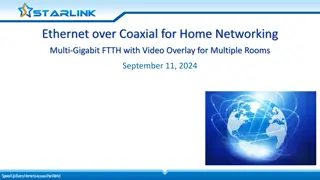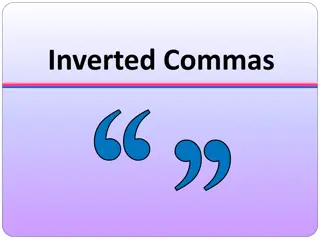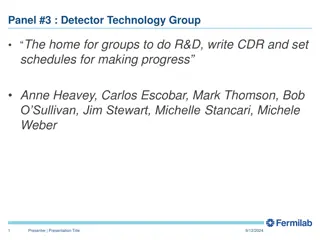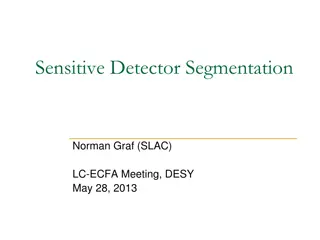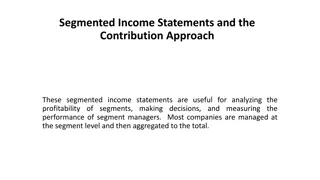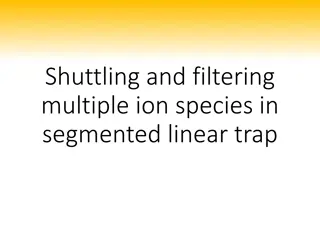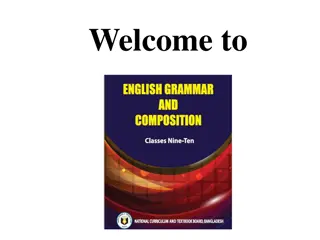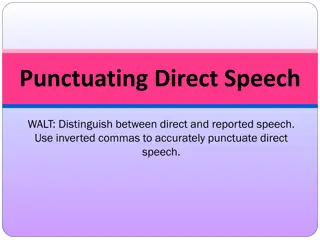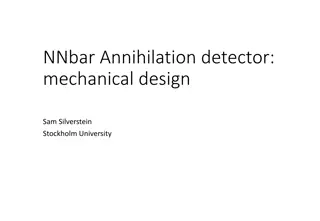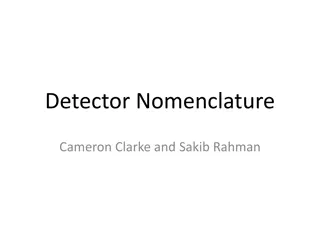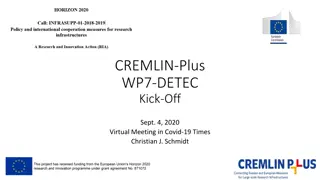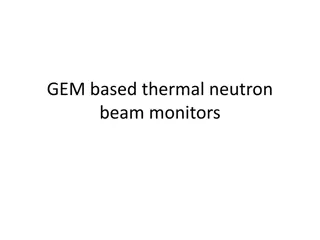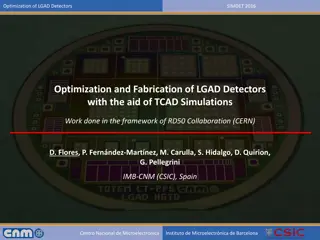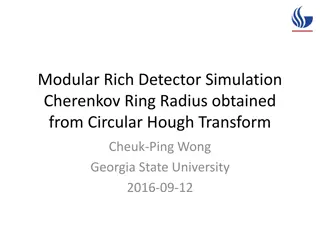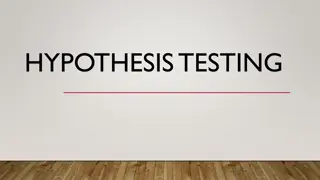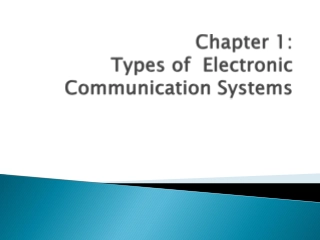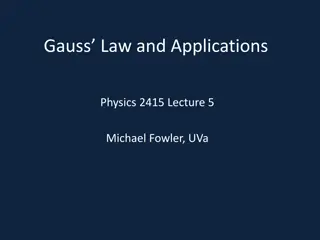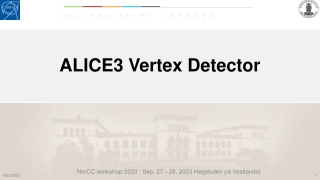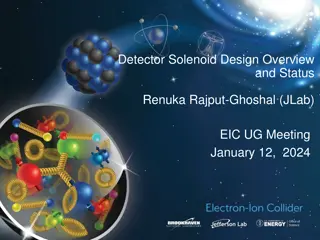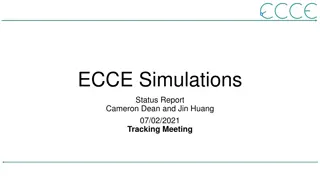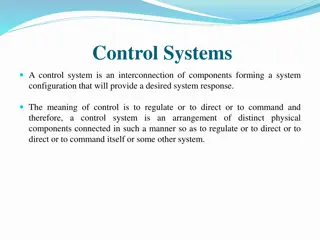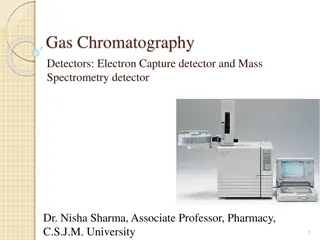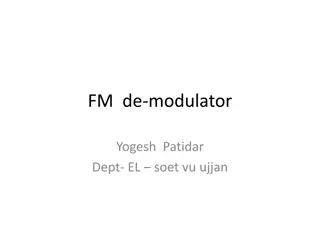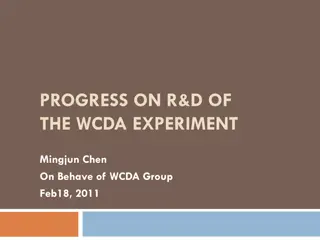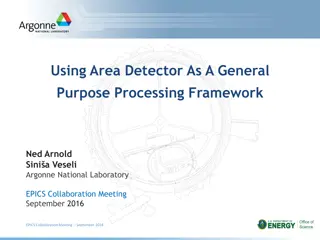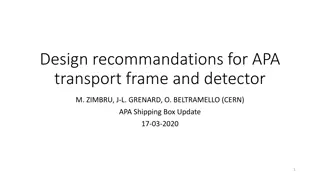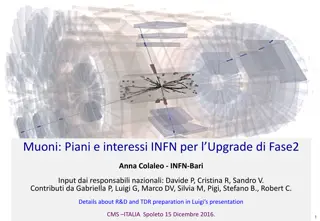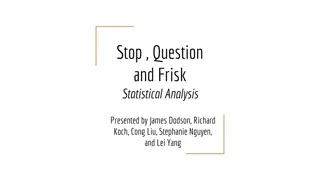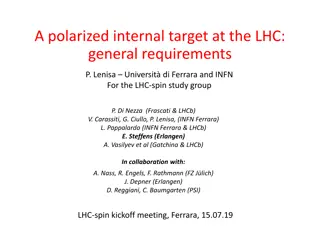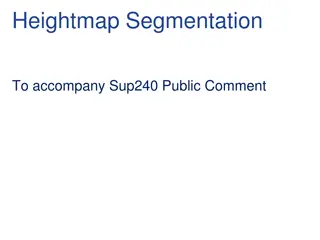Innovative n-Type Segmented Inverted Coaxial HPGe Detector Study
Comprehensive characterization of an n-type Segmented Inverted Coaxial Point Contact (ICPC) detector by Heather Crawford at the AGATA-GRETINA collaboration meeting. The study focuses on energy resolution, drift time corrections, azimuthal angle and full position reconstruction, along with in-beam characterization work. The detector offers improved charge drift time variation, direct identification of interactions, and precise determination of charge arrival time. Utilizing electrode segmentation and point-contact technology, the detector shows promising position resolution capabilities. The prototype detector produced by Canberra France for David Radford features unique design elements such as individual segments, point contact, and concentric circular electrodes.
Uploaded on Sep 14, 2024 | 0 Views
Download Presentation

Please find below an Image/Link to download the presentation.
The content on the website is provided AS IS for your information and personal use only. It may not be sold, licensed, or shared on other websites without obtaining consent from the author. Download presentation by click this link. If you encounter any issues during the download, it is possible that the publisher has removed the file from their server.
E N D
Presentation Transcript
Characterization of an n-type Segmented Inverted Coaxial Point Contact (ICPC) Detector Heather Crawford (LBNL) Second AGATA-GRETINA Collaboration Meeting, CSNSM Orsay Campus, CNRS France -- April 4-6,2018
Outline Overview of the n-type Segmented Inverted Coaxial HPGe Point Contact Detector Energy resolution from the point contact Drift time corrections Azimuthal angle reconstruction Full position (r and z) reconstruction In-beam characterization work Next steps
Outline Overview of the n-type Segmented Inverted Coaxial HPGe Point Contact Detector Energy resolution from the point contact Drift time corrections Azimuthal angle reconstruction Full position (r and z) reconstruction In-beam characterization work Next steps Marco Salathe
Inverted Coaxial HPGe Point Contact Detector Novel, large-volume gamma-ray tracking detector combining electrode segmentation and point-contact technology Combines benefits of segmented (GRETA/AGATA) and point contact (MAJORANA/GERDA) detector technologies Strong variation in charge drift time and highly localized point contact weighting potential allows direct identification of number of interactions Signal shape at point contact allows precise determination of charge arrival time Segmentation of outer contacts provides determination of interaction time Knowledge of drift time allows precise determination of interaction position from segments signals Predicted position resolution approximately ~ 0.2mm Factor 3 -4 better than predicted for GRETINA Vetter et al., NIMA 452, 223 (2000). | Cooper et al., NIMA 665, 25 (2011).
n-Type ICPC Prototype Detector Produced by Canberra France for David Radford (ORNL) 7 cm rear diameter; 8 cm length; 10 degree taper over 6 cm of length 20 individual segments Point contact (full volume electrode) on the back 8 wedges surrounding the point contact 8 longitudinal slices on the sides 2 concentric circular electrodes on the front 1 contact in the bore hole (front) Cooper et al., NIMA 665, 25 (2011).
A representative event 60Co Individual event data shows power of slow-drift combined with segmentation Along z (vertical), slices clearly show drift of charge from first interaction point toward PC Second hit (back) is located by wedge signals (net + neighbours) Drift time (segment time --> PC time) refines z information
Charge Trapping in the n-type ICPC For n-type material electron trapping is significant even at standard impurity levels (without damage) Large variation in drift times, paths and the associated trapping strongly degrades the resolution (and peak shape) Can HPGe resolution be recovered? Salathe et al., NIMA 868, 19 (2017).
Charge Trapping: Drift Time Correction To a first approximation, charge trapping increases linearly with drift time Division of data into (100ns) drift-time slices and calculation of centroid provides first linear correction Salathe et al., NIMA 868, 19 (2017).
Charge Trapping: Drift Time Correction Simple linear correction works well at low drift- times, i.e. close to the PC where electrons are ultimately collected Divergence at long drift- times shows clear dependence of resolution on other parameters Salathe et al., NIMA 868, 19 (2017).
Charge Trapping: Azimuthal Angle Effect Beyond drift-time -- an approximate proxy for depth (z) -- other obvious parameters are radius and azimuthal angle Strong variation in the amount of trapping is clearly observed at different azimuthal angles Salathe et al., NIMA 868, 19 (2017).
Azimuthal Angle Reconstruction: Building a Basis An experimental basis for azimuthal angle reconstruction was built A ring of collimated vertical 137Cs measurements were taken in the detector at a radius of 24 mm, with 2.5 degree spacing Photopeak events satisfying A/E cut were averaged to build a basis at each angle, considering on the rear 8 wedge segments 1. 2. Salathe et al., NIMA 868, 19 (2017).
Azimuthal Angle Reconstruction A fit of individual events to the available basis signals, using a 2 minimization, and then a linear interpolation between grid points allows reliable azimuthal angle determination Salathe et al., NIMA 868, 19 (2017).
Charge Trapping: Drift and Angle Correction Uncollimated 60Co measurement (from the crystal front) shows performance of angle-drift time correction For single-site events, now at ~2.9 keV at 1332 keV with these corrections Salathe et al., NIMA 868, 19 (2017).
Radial Position Reconstruction 45 Radial reconstruction is performed following ? determination Signals from the front and longitudinal segments included in bases indexed by observed net segment, ? and drift time Least-squares 2 minimization and interpolation between basis points determines r position Good performance achieved with (at this point) single iteration of fitting step, except in region very near point contact (r = 0)
Depth (z) Reconstruction With ? and r reconstruction, determination of zis simply a look-up table to map drift time to depth Challenges near the PC arise due to double-valued z vs drift time relationship
Pencil Beams: Attenuation in HPGe Overall position reconstruction approach is well-understood Performance for single-site interactions is good better than 0.5 in ?, of order 1 mm in r, z from scanning results through most of crystal volume Single pencil beam shows r with of ~ 1.2-1.3 mm; z profile matches well attenuation length in Ge
In-Beam Test of Position Resolution Doppler broadening is dominated by effective position resolution (opening angle) Placement of detector within ~6cm (at 90 ) of target position allows measurement of position resolution with precision < 0.5 mm 84Kr(12C, 4n)92Mo 84Kr at 395 MeV onto 45 g/cm2 C target 92Mo residues recoil at v/c ~ 0.09
In-Beam Test of Position Resolution Doppler broadening is dominated by effective position resolution (opening angle) Placement of detector within ~6cm (at 90 ) of target position allows measurement of position resolution with precision < 0.5 mm 84Kr(12C, 4n)92Mo 84Kr at 395 MeV onto 45 g/cm2 C target 92Mo residues recoil at v/c ~ 0.09 Corrected by Crystal position 26 keV Position from tracking 8 keV Measurement performed for GRETINA engineering run at 18 cm distance, = 2 mm in GRETINA translates to ~ 8keV FWHM for 2 MeV peak(s)
How Does It Look? Point contact data nicely shows Doppler shift as a function of angle ~ 180 Beam
How Does It Look? Point contact data nicely shows Doppler shift as a function of angle ~ 180 Beam
How Does It Look? Point contact data nicely shows Doppler shift as a function of angle Reconstruction for single-site events gives ~ 9 keV FWHM for ICPC Based on simulations, this corresponds to x,y,z ~ 1.5 mm ~ 180 Beam
Next Steps Toward Full Signal Decomposition Main effort to date has been on single-site events (A/E cut, and segment multiplicity = 1) Next steps are to extend position reconstruction to include (a) charge sharing events and (b) multi-site events Number of interactions will be constrained by point contact signal and number of net charge segments Maintain azimuthal, and then r reconstruction approach, but iterate over solution(s) as multiple interactions are added Add PC signal to the basis as additional constraint on 2 fit
Summary n-type segmented ICPC prototype characterization measurements have been underway at LBNL for last 2 years Energy resolution after correction for position of interaction (primarily drift time and ?) has reached 2.9 keV at 1332 keV resolution is recovered Full position (?, r and z) reconstruction for single-site events has been achieved with promising first results Next steps toward complete signal decomposition are understood in-beam polarization data has been taken as a test data set (compared directly with clovers) Next steps neutron damage! Stay tuned
Acknowledgements Special thanks: Marco Salathe, Ren Cooper and David Radford (ORNL) Thank you!
Inverted Coaxial HPGe Point Contact Detector Field, weighting potential and signal generation calculations have shown the potential performance gains for such a geometry Cooper et al., NIMA 665, 25 (2011).
Radial Position Reconstruction Collimated 137Cs scans from the center to the outside of the crystal at specific angles were used to build up the r basis Signals from the front and longitudinal segments included; basis was built indexed by observed net segment, ? and drift time 0
n-Type ICPC Prototype Detector @ LBNL Supported by LDRD funding at LBNL, prototype was moved from ORNL to LBNL (88 cyclotron) for characterization work GRETINA scanning table and infrastructure, capabilities for in- beam testing have allowed a thorough investigation of the detector Cooper et al., NIMA 665, 25 (2011).


